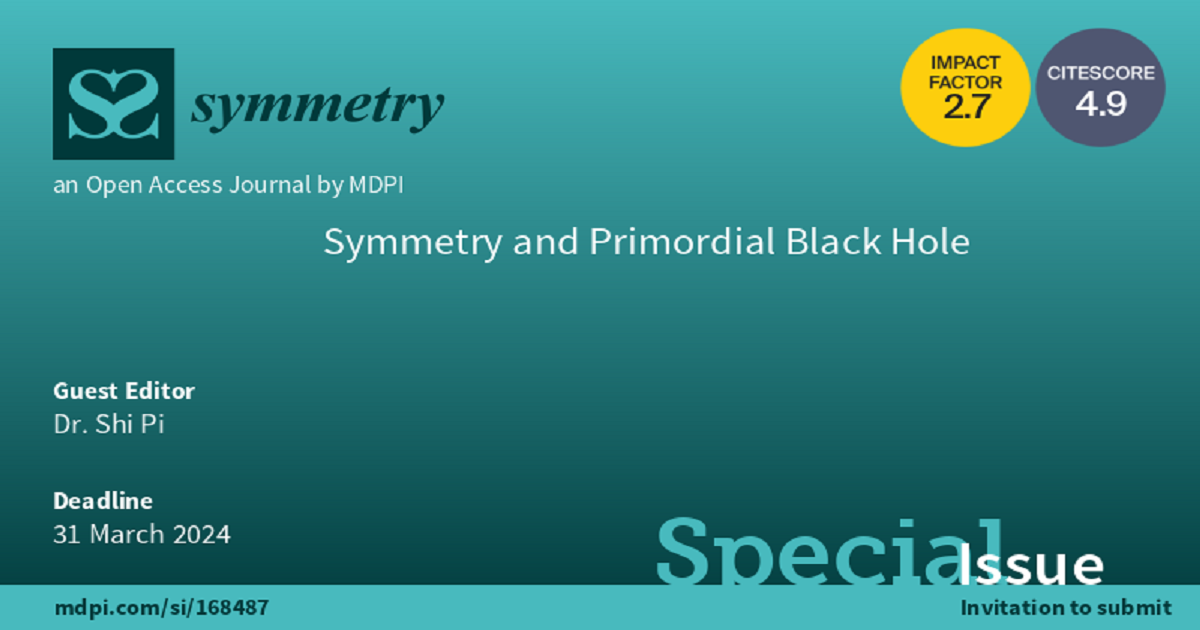Symmetry and Primordial Black Hole
A special issue of Symmetry (ISSN 2073-8994). This special issue belongs to the section "Physics".
Deadline for manuscript submissions: closed (31 March 2024) | Viewed by 204

Special Issue Editor
Special Issue Information
Dear Colleagues,
Primordial black holes (PBHs) were formed in the early universe due to their large curvature perturbation on small scales when they re-enter the Hubble horizon. The phenomena related to PBHs are very fruitful. They involve the entirety of dark matter, some of the LIGO detections, seeds for galaxy and structure formation, hot spots for baryogenesis, etc. The related physics includes ultra-slow-roll inflation, multifield inflation, stochastic inflation, nonlinearity of the curvature perturbation, pairing and clustering of PBHs in the early universe, phase transition and the change of equation of state, microlensing, Hawking radiation and its remnant, profile of dark matter halo, induced gravitational waves, stochastic gravitational waves from the binary PBHs, etc.
The study of symmetry and primordial black holes continues to play an important role in our ongoing efforts to better understand the fundamental physics of our universe. The aim of this Special Issue is to encourage the publication of original research papers in a wide variety of fields related to PBHs in which theoretical or practical results of symmetry can be applied. Relevant topics include, but are not limited to:
- Formation mechanisms: There are several proposed mechanisms for the formation of PBHs, including the collapse of density perturbations in the early universe, the collapse of cosmic strings, and the collision of bubbles during a phase transition;
- Mass spectrum: The mass spectrum of PBHs can provide insights into the small-scale power spectrum of the curvature perturbation, as well as into the physics of the early universe. Additionally, the calculation of the PBH mass spectrum has some uncertainties, depending on the methods employed;
- Observational constraints: Various observational techniques have been proposed for probing PBHs, including microlensing, extra-galactic gamma rays, CMB μ- and y-distorsion, dynamical constraints, and indirect probe by scalar-induced gravitational waves;
- Induced gravitational waves: The stochastic gravitational wave background induced by the scalar perturbation, which is usually accompanied by the PBH formation by such large scalar perturbations, provides an indirect probe of PBHs. Additionally, such waves are the important scientific goals of the space-borne interferometers and pulsar timing arrays;
- Early universe implications: PBHs were generated in the very early universe, of which the thermal history as well as the formation mechanisms can be probed by the use of PBHs. For instance, the softening of the equation of state in the QCD era can enhance the PBH formation, thus generating a peaked PBH mass function around 1 solar mass, which could be detectable for some inflation models. Besides, the PBHs generated by bubble nucleation reflect the property of first-order phase transition;
- Distinguish with astrophysical black holes: Primordial black holes have some characteristic properties which can be used to distinguish with astrophysical black holes, such as high eccentricity and low spins. Besides, the mass functions of PBHs are also different from those of the astrophysical black holes. Recent LIGO result shows that the mass distribution of black holes which are LIGO-detected deviate from astrophysical predictions, which implies that a portion of such detections might be primordial.
Dr. Shi Pi
Guest Editor
Manuscript Submission Information
Manuscripts should be submitted online at www.mdpi.com by registering and logging in to this website. Once you are registered, click here to go to the submission form. Manuscripts can be submitted until the deadline. All submissions that pass pre-check are peer-reviewed. Accepted papers will be published continuously in the journal (as soon as accepted) and will be listed together on the special issue website. Research articles, review articles as well as short communications are invited. For planned papers, a title and short abstract (about 100 words) can be sent to the Editorial Office for announcement on this website.
Submitted manuscripts should not have been published previously, nor be under consideration for publication elsewhere (except conference proceedings papers). All manuscripts are thoroughly refereed through a single-blind peer-review process. A guide for authors and other relevant information for submission of manuscripts is available on the Instructions for Authors page. Symmetry is an international peer-reviewed open access monthly journal published by MDPI.
Please visit the Instructions for Authors page before submitting a manuscript. The Article Processing Charge (APC) for publication in this open access journal is 2400 CHF (Swiss Francs). Submitted papers should be well formatted and use good English. Authors may use MDPI's English editing service prior to publication or during author revisions.
Keywords
- primordial black hole
- symmetry
- cosmological perturbation theory
- early universe
- inflation
- curvature perturbation
- single-field inflation
- Hawking radiation
- microlensing
- ultra-compact object
- induced gravitational waves
- stochastic gravitational waves
- space-borne interferometer
- LISA
- Taiji
- TianQin
- pulsar timing array
- loop corrections to inflation
- ultra-slow-roll inflation
- constant-roll inflation
- stochastic inflation
- primordial black hole binary
- gravitational collapse
- sphericity
- closed universe
- the big crunch
- peak theory of random fields
- Press-Schechter mechanism
- critical collapse
- femtolensing
- CMB mu-distortion
- CMB y-distortion
- supermassive black holes
- merger rate
- origin of black holes
- black hole mass function
- black hole clustering





